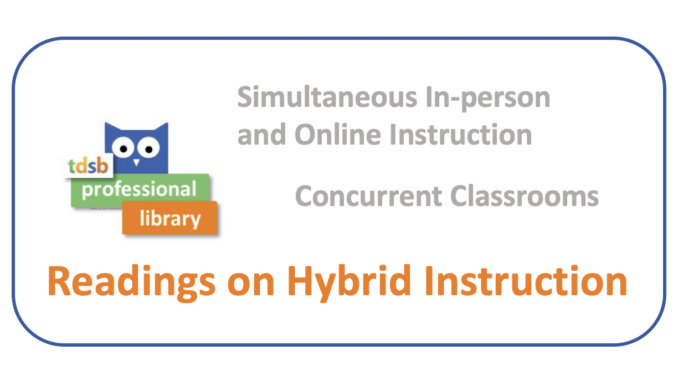
AKA Simultaneous In-person and Online Instruction – Concurrent Classrooms: A few How-to’s, and a few Critiques
By Judy Ameline & Judy Chyung
This list was curated by Librarians at the TDSB Professional Library in the Library Learning Resources and Global Education Department of the Toronto District School Board.
Because this is a current and evolving topic as we continue to navigate education in the time of COVID, we have chosen to include a few Internet Resource Links that are more topical and potentially more time-limited than our typical Book and eBook CSL Journal column reading suggestions. Links to the TDSB Professional Library Catalogue have been provided for informational purposes, but the items are accessible to TDSB staff only.
Books
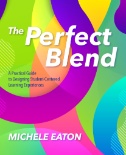
Eaton, M. (2020). The perfect blend: A practical guide to designing student-centered learning experiences. Portland, OR: International Society for Technology in Education. eBook
The author defines blended learning as any combination of traditional instruction and online learning. This book provides practical ideas and strategies on how to incorporate technology to create a blended learning where personalized learning, student voice and choice are emphasized.
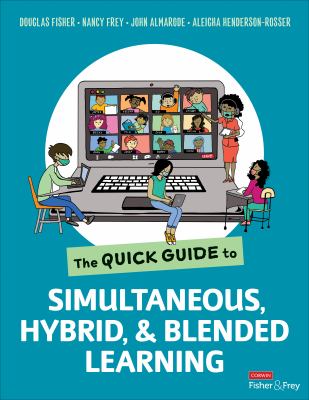
Fisher, D., Frey, N., Almarode, J., & Henderson-Rosser, A. (2021). The quick guide to simultaneous, hybrid, and blended learning. Corwin Press. eBook Also available in Print
This book addresses the unique teaching needs related to simultaneous learning where there are some learners at a distance and others face-to-face learning in the same learning experience. For better learning experience and student engagement, it describes the importance of clarity for learning, instructional strategies in asynchronous and synchronous learning, and establishing norms, procedures and processes in a simultaneous learning environment.
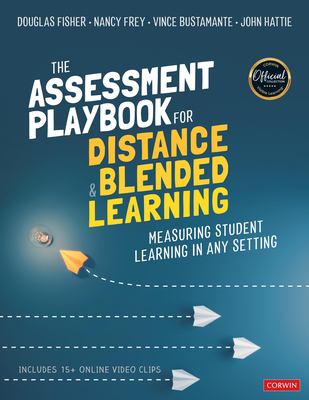
Fisher, D., Frey, N., Bustamante, V., & Hattie, J. (2021). Assessment playbook for distance & blended learning: Measuring student learning in any setting. Thousand Oaks, CA: Corwin Press. eBook
This book shows readers how to design and implement assessments that appropriately measure and target student learning in distance and hybrid learning environments. A playlist of assessments and tips, adapted to the online learning environment, are grouped under the headings: universal response, teach-back, assessment through composition, self and peer assessment.
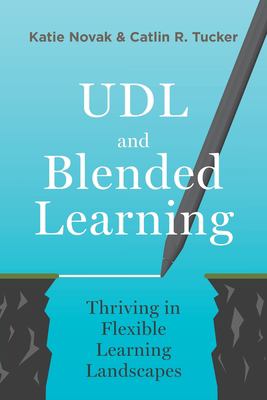
Novak, K., & Tucker, C. (2021). UDL and blended learning: Thriving in flexible learning landscapes. IMpress (Dave Burgess Consulting).
The authors help readers understand that the Universal Design for Learning can create lessons flexibility enough to work for all learners in the blended learning environment where students are active and engaged, with a focus on cultivating community, building equity, and increasing accessibility for all learners.
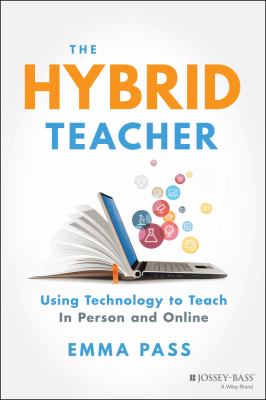
Pass, E. (2021). The hybrid teacher: Using technology to teach in person and online. Hoboken, NJ: Jossey-Bass. eBook
The most effective hybrid teachers are familiar with a wide range of instructional strategies, technologies, tools, and resources, and build positive relationships with students both in-person and online. The Hybrid Teacher: Using Technology to Teach In-Person and Online will teach educators to leverage the technology available to them both in their traditional brick-and-mortar classrooms and in remote learning environments. This book is a practical guide for teachers seeking to prepare for distance instruction and to leverage best practices to bring back to their physical classrooms. This resource also highlights the impact of social and economic differences on students’ ability to effectively use classroom technology, and provides strategies and advice for maximizing success in both physical and virtual classrooms.
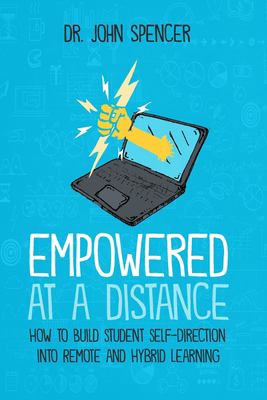
Spencer, J. (2020). Empowered at a distance: How to build student self-direction into remote and hybrid learning. Salem, OR: Blend Education. Print
Engaging students can be difficult in both virtual and hybrid learning, particularly when the transition is unexpected. Students may struggle to show up to class and fail to submit their assignments on time. Often, the issue isn’t a lack of engagement but rather a lack of initiative and self-direction. This resource provides teachers, coaches, and administrators with advice for structuring successful remote teaching and how to use reflection, student choice, and flexibility to build community and empower students.
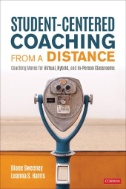
Sweeney, D., & Harris, LS. (2021). Student-centered coaching from a distance: Coaching moves for virtual, hybrid, and in-person classrooms. Corwin Press. eBook
Student-Centered Coaching from a Distance was written to help coaches and teachers adapt to new ways of learning and instruction. Each chapter includes technology-focused coaching ‘moves’ along with tools that provide structure and coherence to coaching conversations. The book also outlines specific strategies that promote equity and work to remove many of the barriers that have been brought into clearer focus by the COVID-19 pandemic.
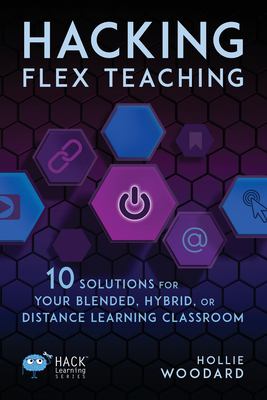
Woodard, H. (2021). Hacking flex teaching: 10 solutions for your blended, hybrid, or distance learning classroom. Times 10 Publications. Print
Education and technology have come together, resulting in changes to the way we teach and the way students learn. The solutions and best practices outlined in Hacking Flex Teaching apply to all virtual classrooms: blended, hybrid, livestream, and distance learning. Topics covered include:
- Harnessing technology for digital and learning equity
- Building an engaging classroom culture in any environment
- Creating personalized learning through the gradual release of responsibility
- Achieving the best possible learning outcomes with the least amount of work
- Selecting instructional and assessment strategies that best correspond to a range of teaching styles and meet the needs of all students
Internet Resources
Stewart, B. (2021, Aug 16). ‘Hybrid learning’ in Ontario schools will rob children of quality education. The Conversation.
Explores issues behind some education advocates in the Greater Toronto Area’s York and Peel regions calling for school boards to say no to hybrid learning.
Farhadi, B. (2021, Sept. 9). Failed screen test: Hybrid learning and the misuse of online education in Ontario. The Monitor.
Describes the current Ontario reality in which Districts confronting a third year of disruption, with a mandate to deliver full-time online education, are normalizing the pandemic hybrid model. Identifies and documents the dangers of this emergency response to COVID-19 pressures .
Joseph, M. X. (2021). How to start a hybrid learning center: A hybrid learning center can help you maximize simultaneous learning. Tech & Learning.
Provides implementation approaches and information on how a hybrid learning center model can support simultaneous learning.
Mason, J. (2020, Sept. 21). How do I teach online and in person at the same time? Your questions, answered. We Are Teachers.
People for Education. (2021, Aug 31). Comparing school COVID-19 policies across Canada.
Includes a chart-form overview of implementation of Hybrid Learning in Provinces and Territories.
Tucker, C. (2020, Feb 11). Navigating the concurrent classroom. ASCD.
Outlines and provides instructional strategies to mitigate four major challenges in hybrid classrooms.
Tucker, C. (2021, Jan 23). Teaching in the concurrent classroom: Four strategies to make it work.

Judy Ameline is a librarian at the Toronto District School Board Professional Library with almost 30 years experience providing reference service. She is passionate about providing TDSB teachers and leaders access to current, cutting edge information in the field of education to support their professional development needs. Check out the Library’s Pinterest Boards and follow her on Twitter @AmelineJudy

Judy Chyung has extensive experience providing Education Reference and Online Services to the educators and leaders of Toronto District School Board at the TDSB Professional Library. She enjoys reading and learning about the trends in education literature, and assisting TDSB educators with their information needs whether for their classroom support or for their professional learning. One of the initiatives that she leads is the curated Resource Guides for Heritage Months celebrated by TDSB. You can check out the Guides at http://bit.ly/DirectoryHeritageMonthListsPL. Currently she is deeply involved in developing Subject Guides to support TDSB educators and students with their curriculum resource needs. These Subject Guides can be found in the TDSB Virtual Library under the FIND tab.